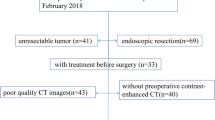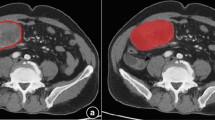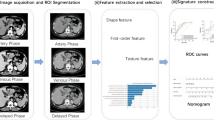Abstract
Purpose
To discriminate the risk stratification in gastrointestinal stromal tumors (GISTs) by preoperatively constructing a model of nonenhanced computed tomography (NECT).
Methods
A total of 111 GISTs patients (77 in the training group and 34 in the validation Group) from two hospitals between 2015 and 2022 were collected retrospectively. One thousand and thirty-seven radiomics features were extracted from non-contract CT images, and the optimal radiomics signature was determined by univariate analysis and LASSO regression. The radiomics model was developed and validated from the ten optimal radiomics features by three methods. Covariates (clinical features, CT findings, and immunohistochemical characteristics) were collected to establish the clinical model, and both the radiomics features and the covariates were used to build the combined model. The effectiveness of the three models was evaluated by the Delong test.
Results
The experimental results showed that the clinical models (75.3%, 70.6%), the radiomics models (79.2%, 79.4%) and the combined models (81.8%, 82.4%) all had high accuracy in predicting the pathological risk of GIST in both training and validation groups. The AUC values of the combined models were significantly higher in both the training groups (0.921 vs 0.822, p= 0.032) and the validation groups (0.913 vs 0.792, p= 0.019) than that of the clinical models. According to the calibration curve, the combined model nomogram is clinically useful.
Conclusions
The clinical-radiomics combined model and based on NECT performed well in discriminating the risk stratification in GISTs. As a quantitative technique, radiomics is capable of predicting the malignant potential and guiding treatment preoperatively.








Similar content being viewed by others
Data availability statement
Data from this study are patient-private and not available to the public. Other researchers may request data from corresponding authors if necessary.
References
Cannella R, Grutta LL, Midiri M, Bartolotta TV (2020) New advances in radiomics of gastrointestinal stromal tumors. World J Gastroenterol 26(32):4729–4738
Casali PG et al (2021) Final analysis of the randomized trial on imatinib as an adjuvant in localized gastrointestinal stromal tumors (GIST) from the EORTC Soft Tissue and Bone Sarcoma Group (STBSG), the Australasian Gastro-Intestinal Trials Group (AGITG), UNICANCER, French Sarcoma Group (FSG), Italian Sarcoma Group (ISG), and Spanish Group for Research on Sarcomas (GEIS)☆. Ann Oncol 32(4):533–541
Chen Y et al (2019) Radiomics model of contrast-enhanced computed tomography for predicting the recurrence of acute pancreatitis. Eur Radiol 29(8):4408–4417
Cheng G, Tse J, Jain RK, Munn LL (2009) Micro-environmental mechanical stress controls tumor spheroid size and morphology by suppressing proliferation and inducing apoptosis in cancer cells. PLoS One 4(2):e4632
Chu H et al (2021) Value of radiomics model based on enhanced computed tomography in risk grade prediction of gastrointestinal stromal tumors. Sci Rep 11(1):12009
Demirjian NL et al (2022) CT-based radiomics stratification of tumor grade and TNM stage of clear cell renal cell carcinoma. Eur Radiol 32(4):2552–2563
Eertink JJ et al (2022) Quantitative radiomics features in diffuse large B-Cell lymphoma: does segmentation method matter? J Nucl Med 63(3):389–395
Gillies RJ, Kinahan PE, Hricak H (2016) Radiomics: images are more than pictures, they are data. Radiology 278(2):563–577
Hemming ML et al (2021) HAND1 and BARX1 act as transcriptional and anatomic determinants of malignancy in gastrointestinal stromal tumor. Clin Cancer Res 27(6):1706–1719
Huang Y et al (2016) Development and validation of a radiomics nomogram for preoperative prediction of lymph node metastasis in colorectal cancer. J Clin Oncol 34:2157–2164
Inoue A et al (2019) Comparison of characteristic computed tomographic findings of gastrointestinal and non-gastrointestinal stromal tumors in the small intestine. Abdom Radiol 44(4):1237–1245
Joensuu H (2008) Risk stratification of patients diagnosed with gastrointestinal stromal tumor. Hum Pathol 39(10):1411–1419
Kadado KJ, Abernathy OL, Salyers WJ, Kallail KJ (2022) Gastrointestinal stromal tumor and Ki-67 as a prognostic indicator. Cureus. https://doi.org/10.7759/cureus.20868
Lambin P (2017) Radiomics: the bridge between medical imaging and personalized medicine. Clin Oncol 14(12):749–762
Li H, Ren G, Cai R, Chen J, Wu X, Zhao J (2018) A correlation research of Ki67 index, CT features, and risk stratification in gastrointestinal stromal tumor. Cancer Med 7(9):4467–4474
Lin Y-N et al (2022a) Prediction of gastric gastrointestinal stromal tumors before operation: a retrospective analysis of gastric subepithelial tumors. J Pers Med 12(2):297
Lin A et al (2022b) Radiomics-based precision phenotyping identifies unstable coronary plaques from computed tomography angiography. Cardiovasc Imaging 15(5):13
Liu X et al (2018) Prognostic factors of primary gastrointestinal stromal tumors: a cohort study based on high-volume centers. Chin J Cancer Res 30(1):61–71
Ng F, Kozarski R, Ganeshan B, Goh V (2013) Assessment of tumor heterogeneity by CT texture analysis: can the largest cross-sectional area be used as an alternative to whole tumor analysis? Eur J Radiol 82(2):342–348
Rong J et al (2020) The prognostic value of gender in gastric gastrointestinal stromal tumors: a propensity score matching analysis. Biol Sex Differ 11(1):43
Song Y et al (2021) Radiomics nomogram based on contrast-enhanced CT to predict the malignant potential of gastrointestinal stromal tumor: a two-center study. Acad Radiol 29:806–816
Talmon A et al (2022) Clinical impact of allergy and pre-medication in CT studies with low-osmolality intravenous iodinated contrast media. Clin Radiol 77(3):210–215
Wang M, Feng Z, Zhou L, Zhang L, Hao X, Zhai J (2021) Computed-tomography-based radiomics model for predicting the malignant potential of gastrointestinal stromal tumors preoperatively: a multi-classifier and multicenter study. Front Oncol 11:582847
Wei S (2020) Risk stratification in GIST: shape quantification with CT is a predictive factor. Eur Radiol 30:1856–1865
Xu L (2021) Incidence of gastrointestinal stromal tumor in Chinese urban population: a national population-based study. Cancer Med 10(2):737–744
Yao W et al (2022) Noninvasive method for predicting the expression of Ki67 and prognosis in non-small-cell lung cancer patients: radiomics. J Healthc Eng 2022:1–9
Yoshida M et al (2022) Effects of tube voltage and iodine contrast medium on radiation dose of whole-body CT. Acta Radiol 63(4):458–466
Zhang Q-W (2020) Personalized CT-based radiomics nomogram preoperative predicting Ki-67 expression in gastrointestinal stromal tumors: a multicenter development and validation cohort. Clin Transl Med 9(1):12
Zhang L et al (2020a) Computed tomography-based radiomics model for discriminating the risk stratification of gastrointestinal stromal tumors. Radiol Med (Torino) 125(5):465–473
Zhang Q et al (2020b) Comparison of malignancy-prediction efficiency between contrast and non-contract CT-based radiomics features in gastrointestinal stromal tumors: a multicenter study. Clin Transl Med. https://doi.org/10.1002/ctm2.91
Zhao Y, Feng M, Wang M, Zhang L, Li M, Huang C (2021a) CT radiomics for the preoperative prediction of Ki67 index in gastrointestinal stromal tumors: a multi-center study. Front Oncol 11:689136
Zhao Y et al (2021b) Clinicopathological value of long non-coding RNA profiles in gastrointestinal stromal tumor. PeerJ 9:e11946
Zhou M et al (2018) Non-small cell lung cancer radiogenomics map identifies relationships between molecular and imaging phenotypes with prognostic implications. Radiology 286(1):307–315
Zhou P, Li P, Zhao S, Wu X (2021) Feature interaction for streaming feature selection. IEEE Trans Neural Netw Learn Syst 32(10):4691–4702
Funding
This work was supported by Röntgen Imaging Research Special Project of Medical Research Development Fund Project of Beijing Health Alliance Charitable Foundation (SD202008-015).
Author information
Authors and Affiliations
Contributions
PW conceived and designed the study, wrote the first draft of the manuscript, and analyzed the data. JY conceived and designed the study, data curation, methodology. HQ data collection. JH data collection. ZY article proofreading. QS data collection. CY designed the study and finalized the manuscript, resources, project administration. All authors revised and approved the final manuscript.
Corresponding author
Ethics declarations
Conflict of interest
The authors declare that there is no conflict of interest regarding the publication of this paper.
Ethics statement
The studies involving human participants were reviewed and approved by the Second Affiliated Hospital of Shandong First Medical University and Shandong Cancer Hospital and Institute, Shandong First Medical University and Shandong Academy of Medical Sciences Ethics Committees. The informed consent is waived.
Additional information
Publisher's Note
Springer Nature remains neutral with regard to jurisdictional claims in published maps and institutional affiliations.
Rights and permissions
Springer Nature or its licensor (e.g. a society or other partner) holds exclusive rights to this article under a publishing agreement with the author(s) or other rightsholder(s); author self-archiving of the accepted manuscript version of this article is solely governed by the terms of such publishing agreement and applicable law.
About this article
Cite this article
Wang, P., Yan, J., Qiu, H. et al. A radiomics-clinical combined nomogram-based on non-enhanced CT for discriminating the risk stratification in GISTs. J Cancer Res Clin Oncol 149, 12993–13003 (2023). https://doi.org/10.1007/s00432-023-05170-7
Received:
Accepted:
Published:
Issue Date:
DOI: https://doi.org/10.1007/s00432-023-05170-7




